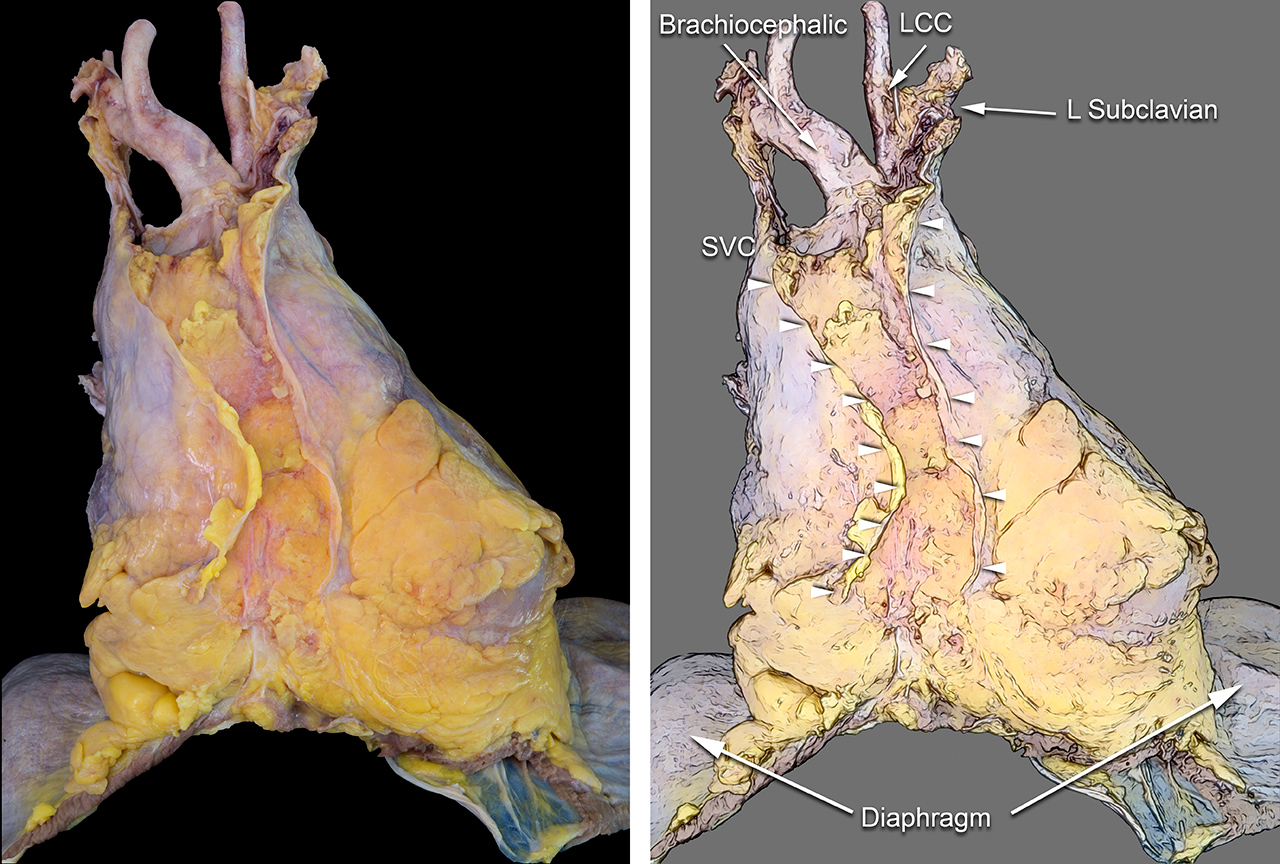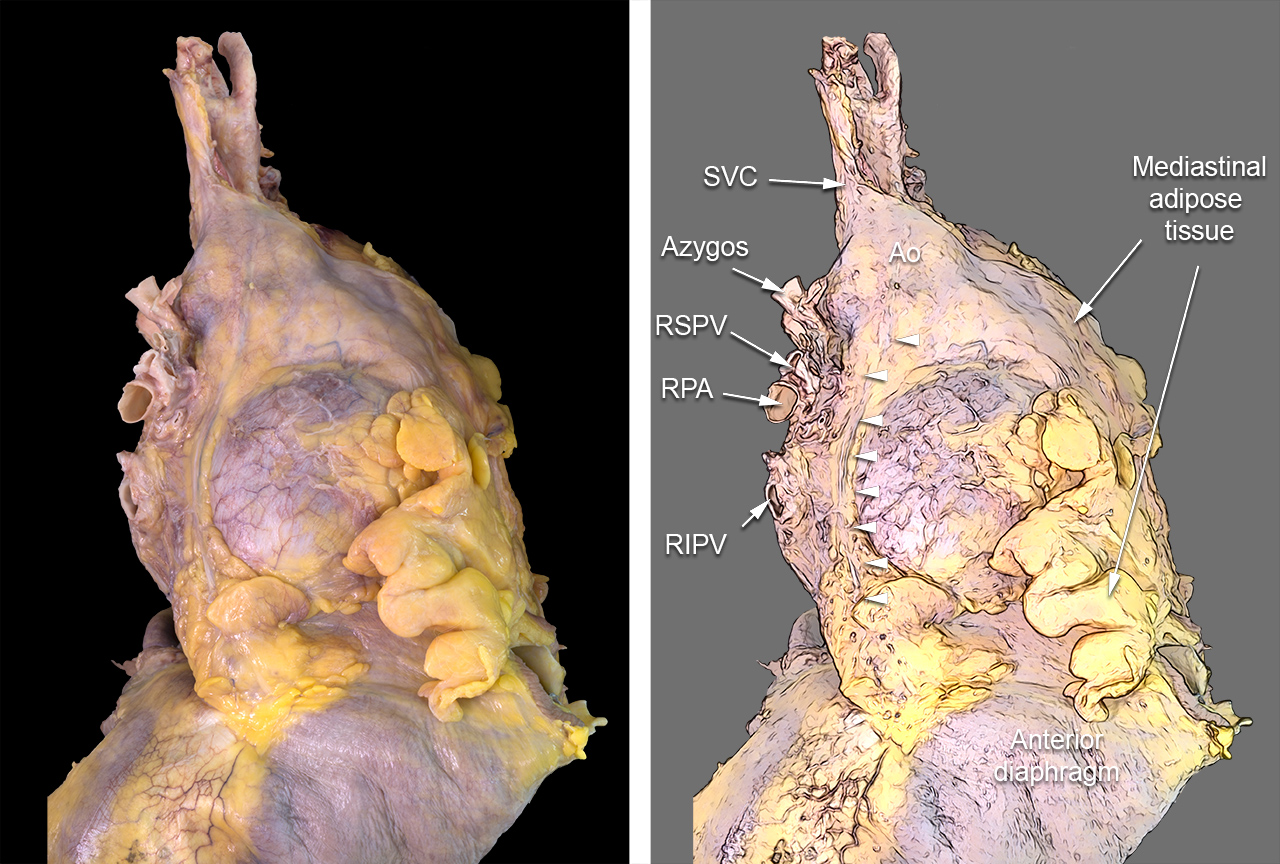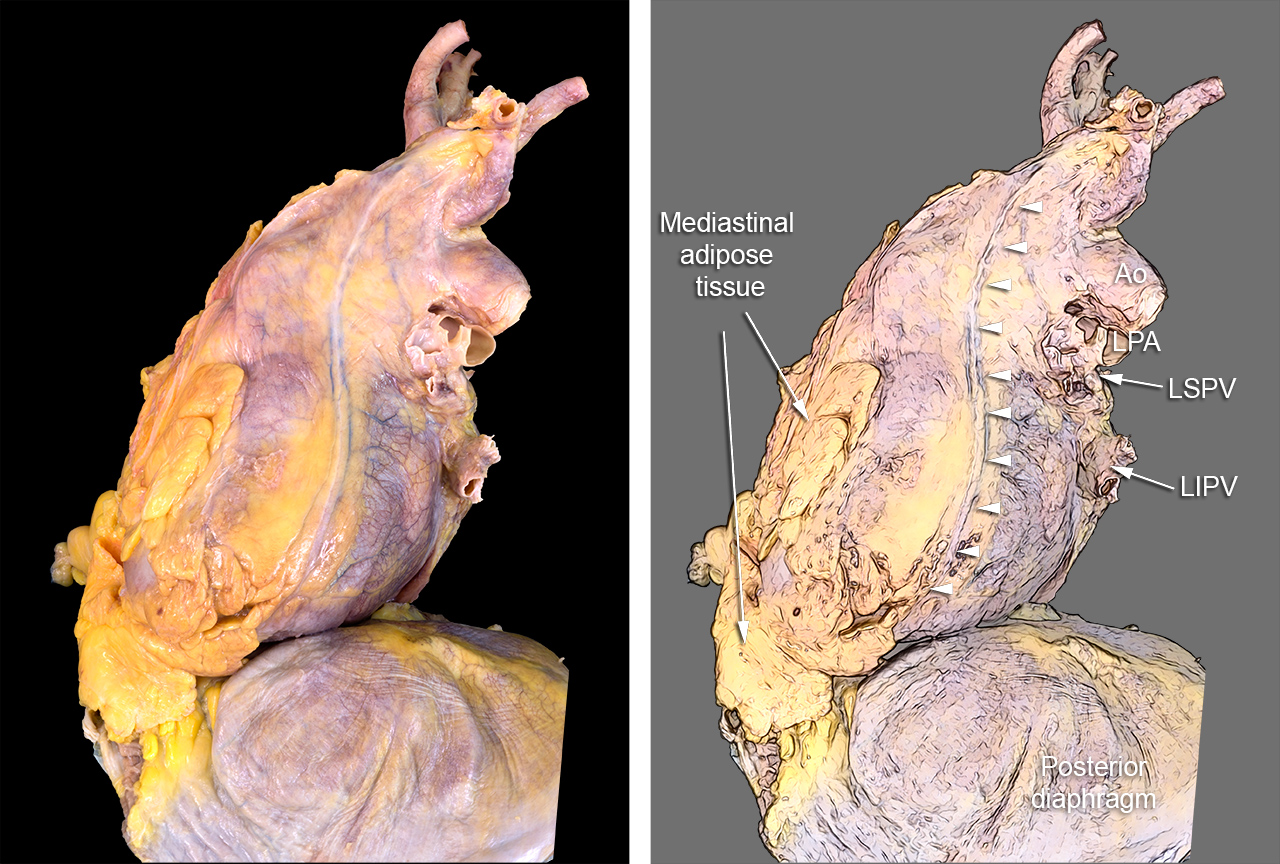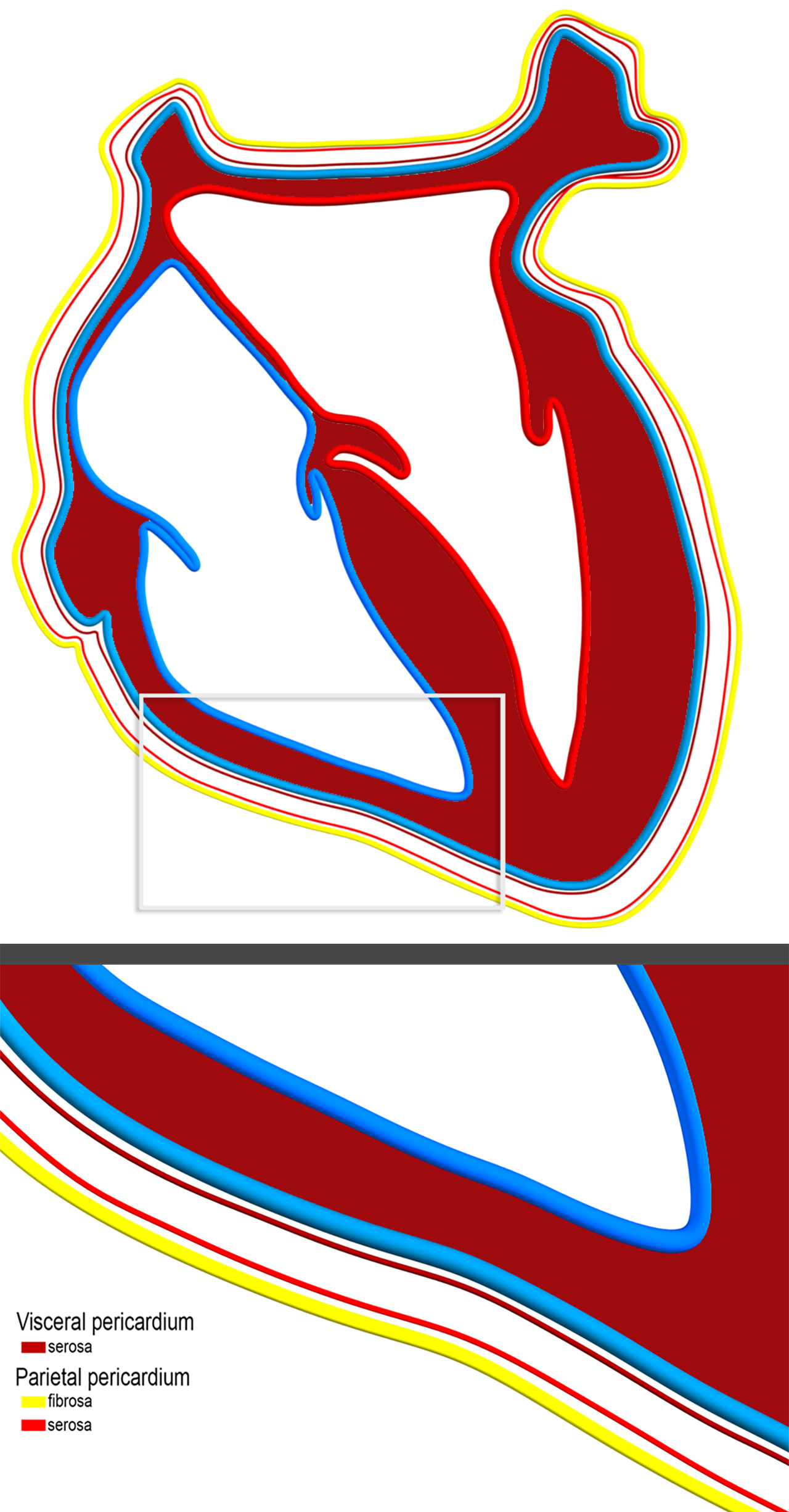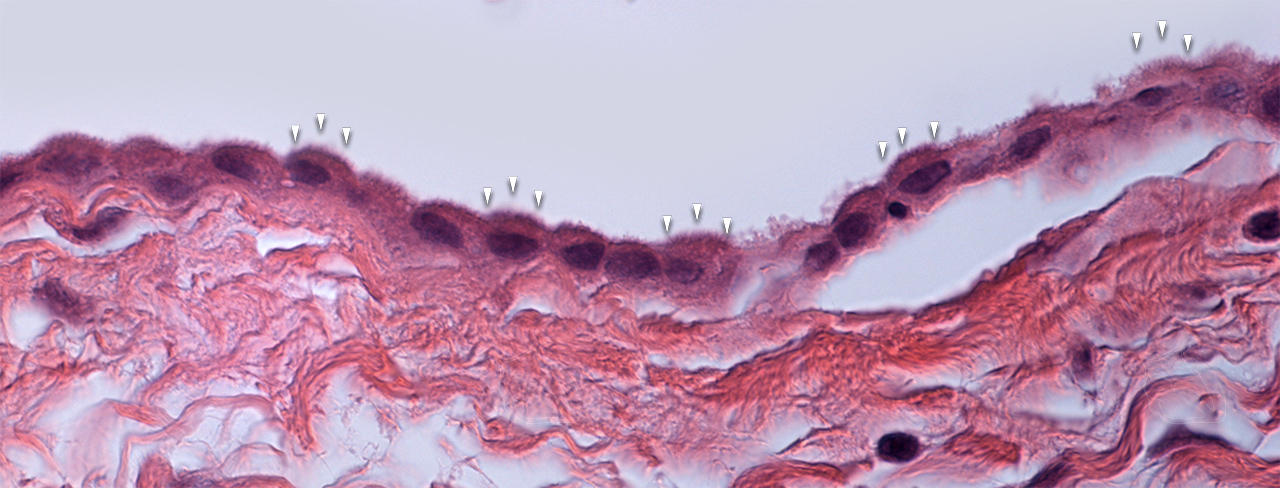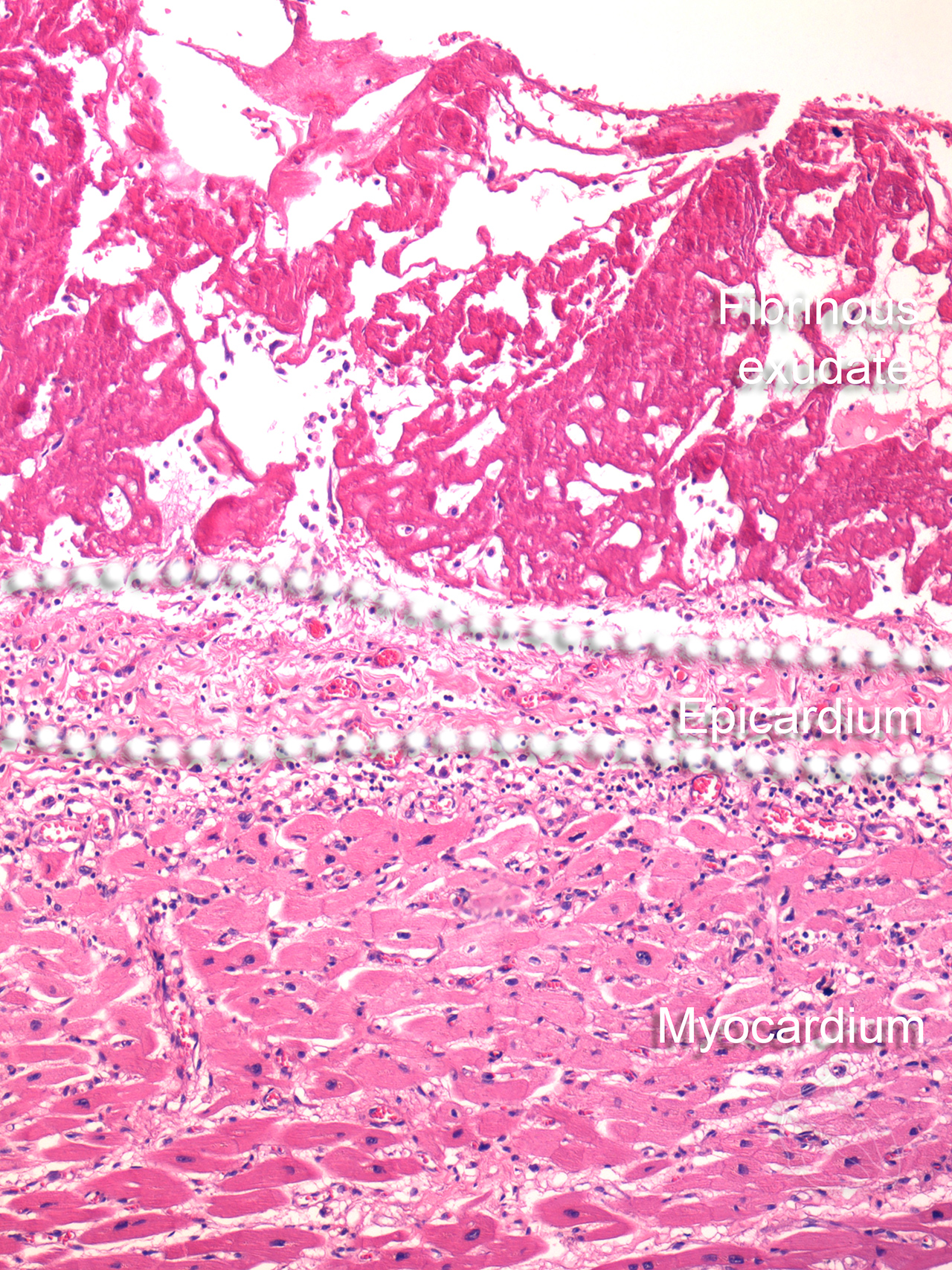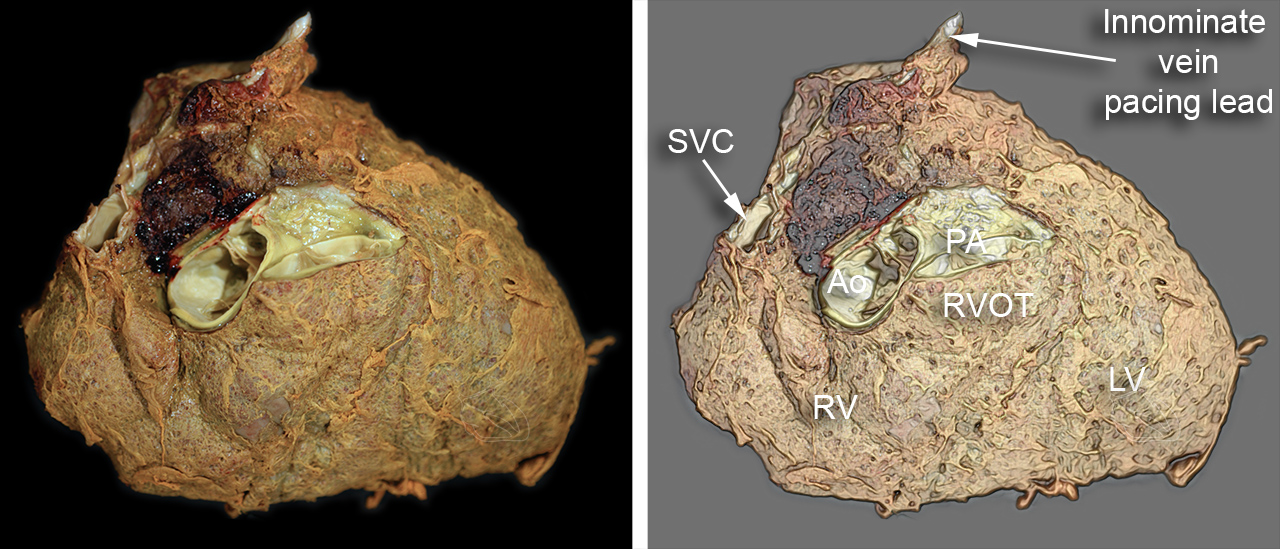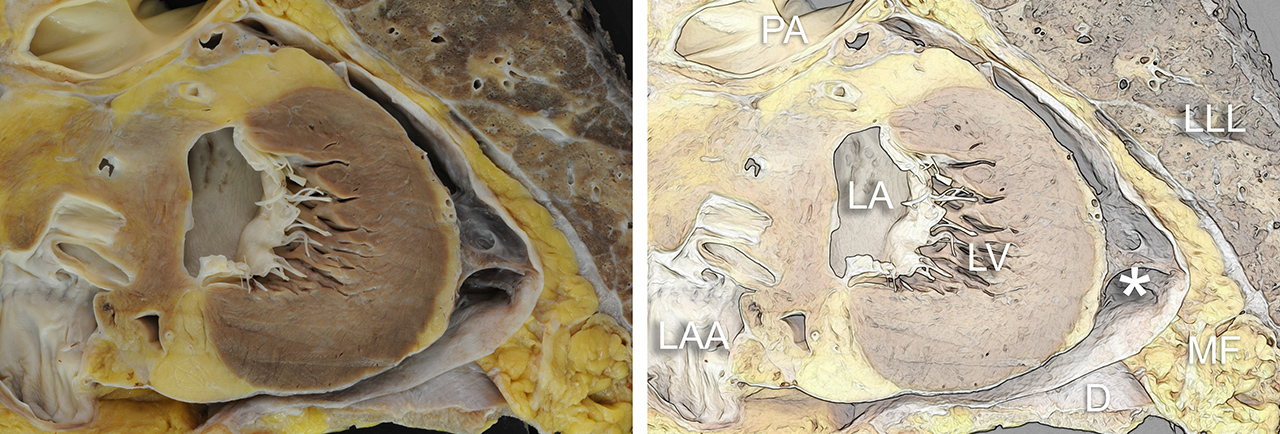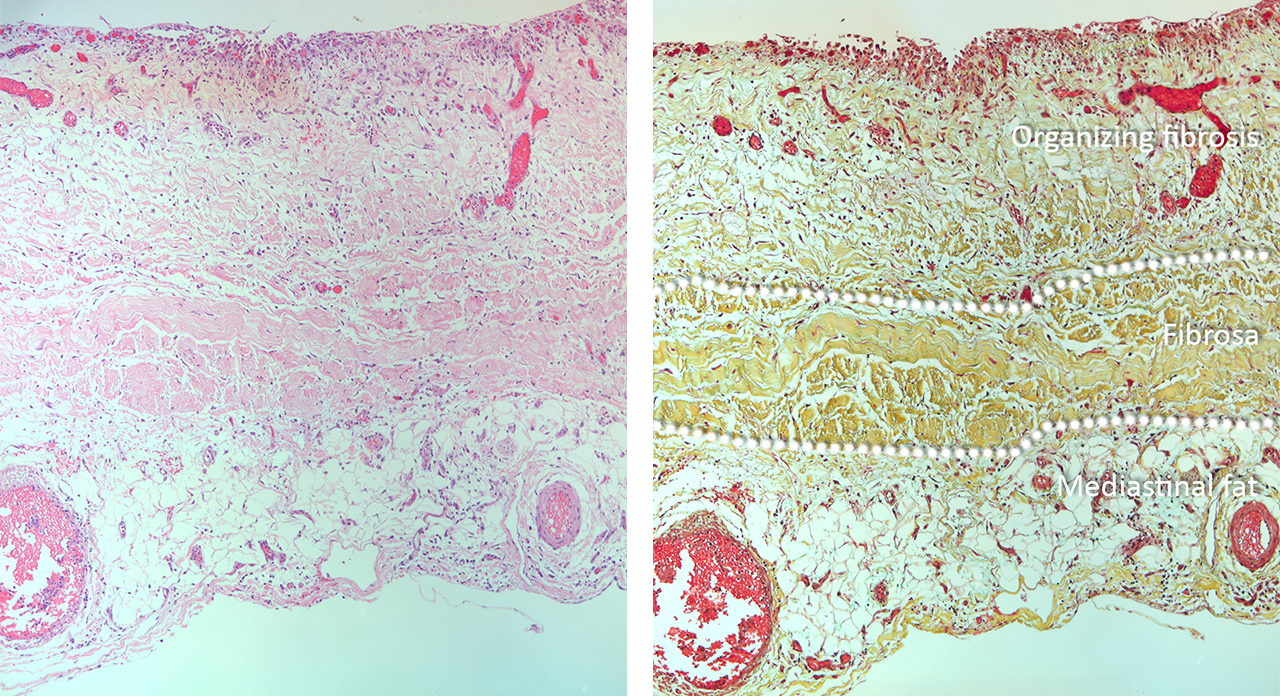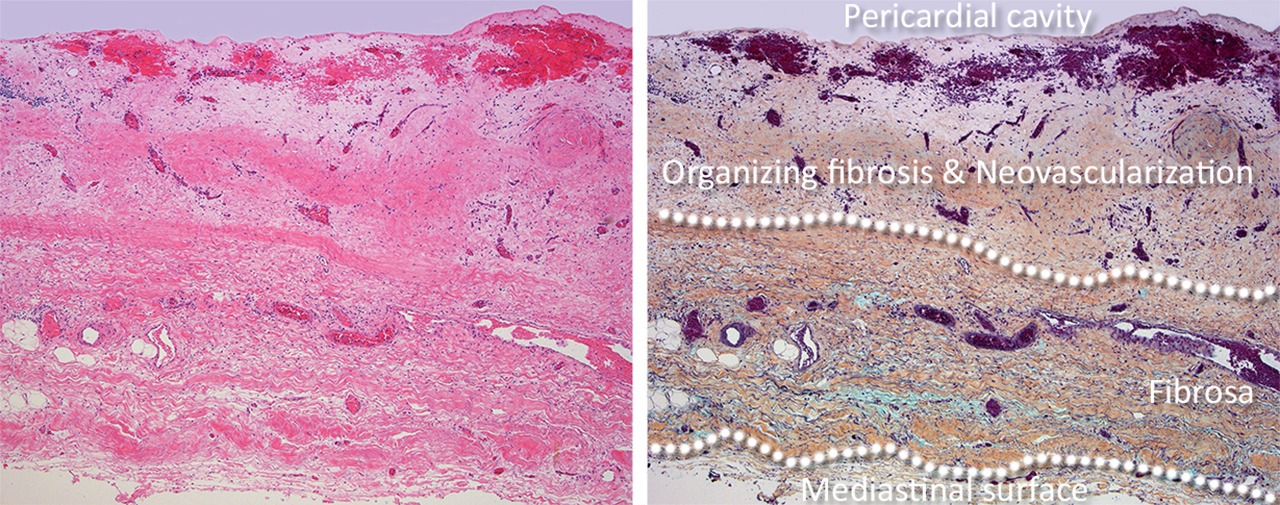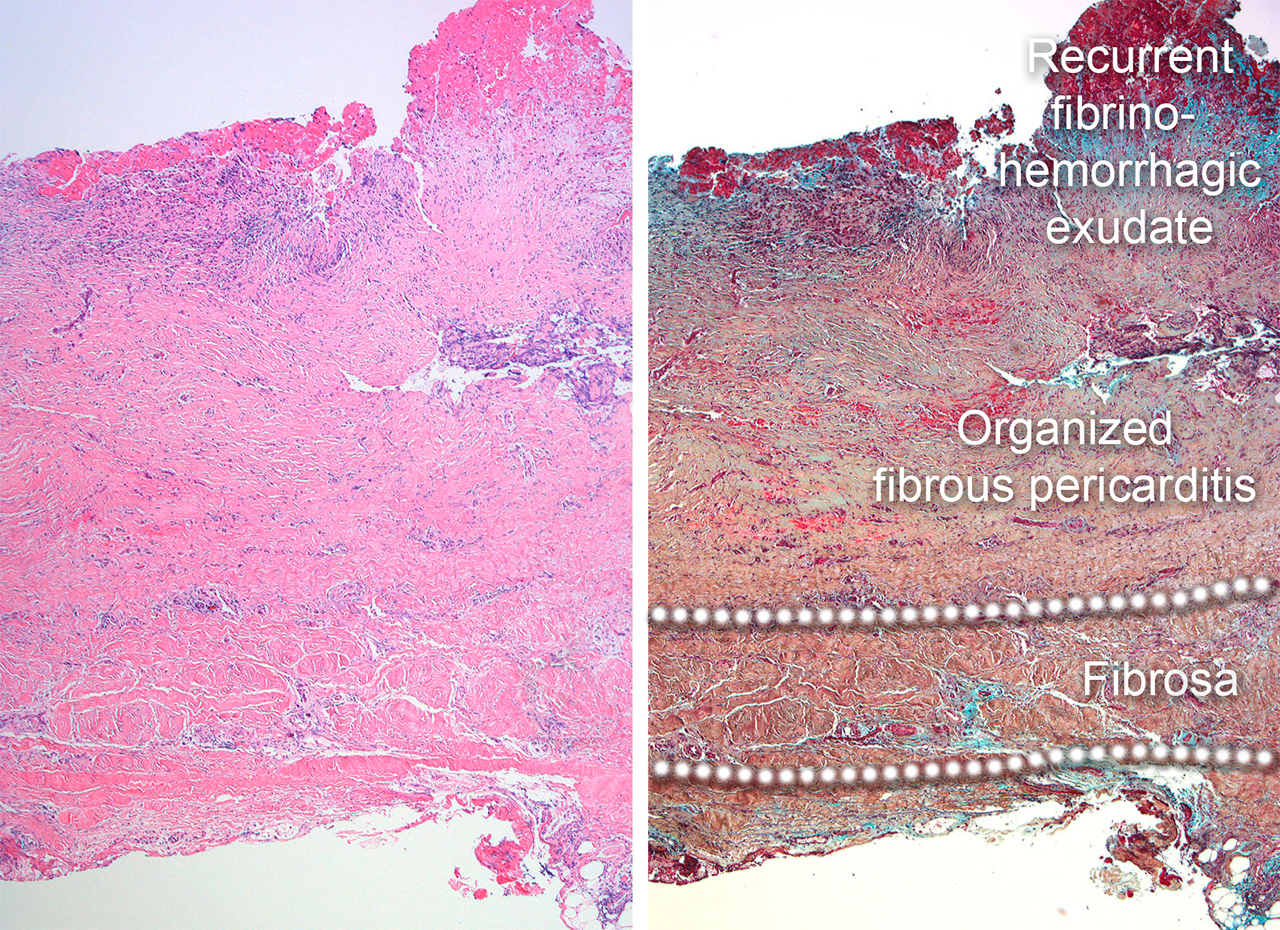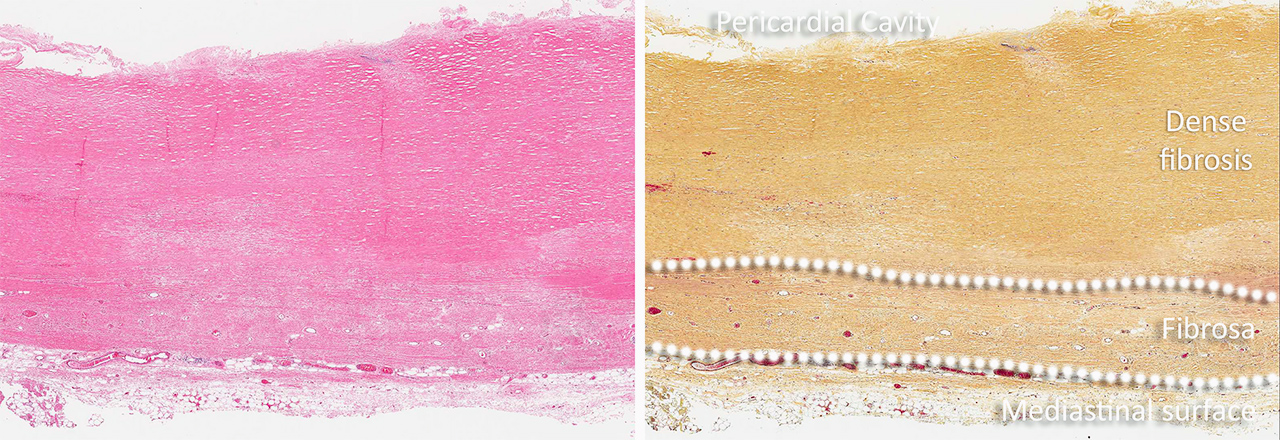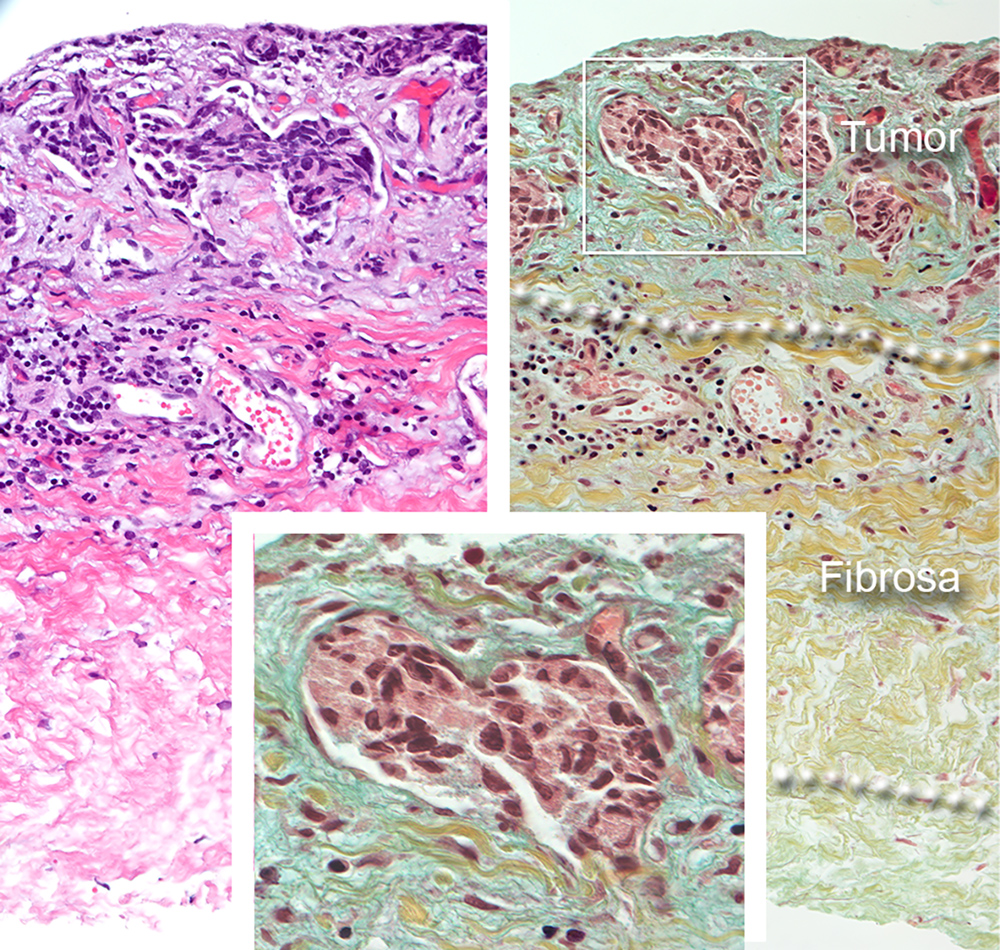The normal gross and microscopic structure of the human pericardium is reviewed in detail. Based on the structural components of the pericardium, the pathologic responses commonly seen in clinical specimens are shown. This provides a correlative explanation to clinical evolution and diagnostic imaging findings such as delayed enhancement in the workup of pericardial disease.
We present the gross and microscopic structure of the pericardium as a frame of reference that can be correlated with current cardiac imaging techniques and interventions. The limited repertoire of responses of the pericardium to diverse pathologic stimuli is illustrated in the context of its normal structure.
A. Gross Structure of the Parietal and Visceral Pericardium
The pericardium is a roughly flask-shaped sac that contains the heart and proximal portions of the great vessels [Figure 1A]. The lateral surfaces of the pericardium are invested by the mediastinal part of the parietal pleura except in those areas where ligaments anchor the pericardium to the sternum, the diaphragm, and the vertebral column. The phrenic nerves and pericardiophrenic vessels are contained in two bundles flanking the lateral contours of the heart [Figure 1B & 1C].
The pericardium is conventionally divided into parietal and visceral pericardium [Figures 2 and 3]. The parietal pericardium consists of an outer fibrous connective tissue sac lined by serosa. The serosal component consists of a single continuous layer of mesothelium that invests the fibrosa layer of the pericardium and extends over the root of the great arteries to completely cover the external surface of the heart. The layer of mesothelium investing the outer surface of the heart is referred to as the visceral pericardium or epicardium. The fibrosa layer of the parietal pericardium is between 0.8 and 1 mm thick but may appear slightly thicker on imaging.1 The pericardial sac is covered by variable amounts of adipose tissue in its mediastinal surface, particularly in the cardiophrenic angles [Figure 1A-C].
Figure 1A
Anterior view of the intact pericardial sac. An intact pericardium attached to the diaphragm is shown with the mediastinal pleura covering the lateral surfaces of the pericardial sac. Note the abundant epipericardial adipose tissue in the anterior mediastinum and anterior cardiophrenic angles. The arrowheads flank the borders of the sternopericardial ligament. LCC = left common carotid artery. SVC = superior vena cava.
Figure 1B
Right lateral view of the heart and pericardium. The right phrenic nerve and pericardiophrenic vessels lie between the parietal pericardium and mediastinal pleura anterior to the pulmonary hilum. The arrowheads highlight these structures. Note the abundant adipose tissue covering the mediastinal surface of the pericardium in the anterior and lateral surfaces. RIPV = right inferior pulmonary vein. RPA = right pulmonary artery. RSPV = right superior pulmonary vein. SVC = Superior vena cava.
Figure 1C
Left lateral view of the heart and pericardium. The course of the left phrenic nerve and accompanying vessels are highlighted by the arrowheads. Ao = aorta. LIPV = left inferior pulmonary vein. LPA = left pulmonary artery. LSPV = left superior pulmonary vein.
Figure 2
Parietal vs. visceral pericardium. The pericardium has, as many other serosal surfaces, a parietal and a visceral component. The parietal pericardium is composed of two layers: a serosal lining (thin red line) and a fibrous sac (thicker yellow line). The visceral pericardium or epicardium is composed of a single layer of serosal investment covering the entire heart (thin red line overlying the myocardium in blue). Note that the serosal lining of the parietal and visceral pericardium is a continuous layer of mesothelial cells. The serosal layer of the parietal and visceral pericardium face each other. The potential space lined by the serosal layers is the pericardial cavity.
Figure 3
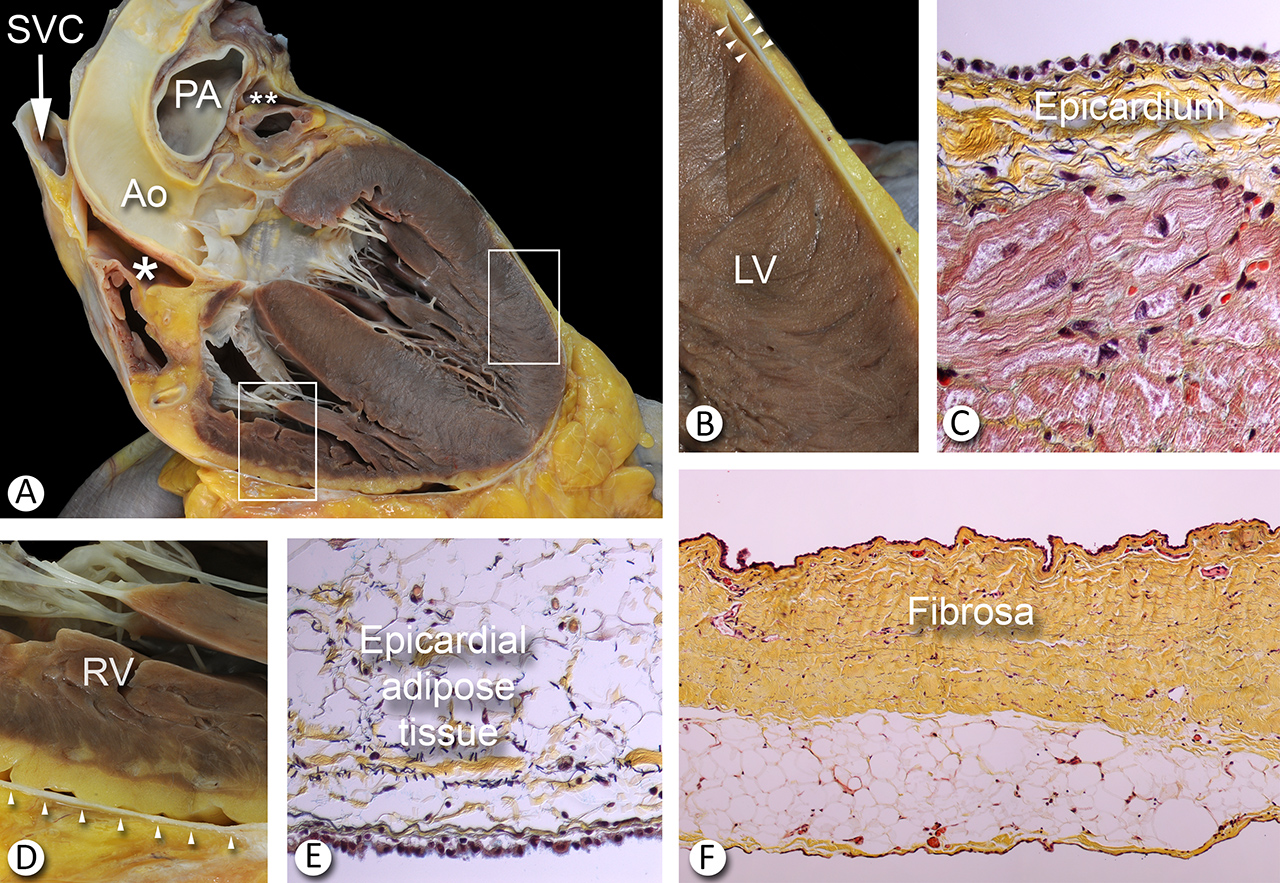
B. Pericardial Sinuses and Recesses
The reflections of the serosa around the great vessels entering and leaving the heart form the pericardial sinuses and recesses.2 The ascending aorta and main pulmonary artery together are completely ensheathed by an investment of the visceral pericardium. This investment creates a potential space, the transverse sinus, which separates the anteriorly located great arteries from the veins posteriorly [Figure 4]. The floor of the transverse sinus is formed by the roof of the left atrium. The transverse sinus is continuous with the superior aortic recess between the aorta and the superior vena cava and the inferior aortic recess between the aorta and the right atrium [Figure 4]. The lateral extensions of the transverse sinus are called the right and left pulmonic recesses.
A second investment of visceral pericardium separately covers the venae cavae and pulmonary veins. The postcaval recess lies behind the superior vena cava and is bounded by the right pulmonary artery superiorly and right superior pulmonary vein inferiorly. The right and left pulmonary venous recesses are formed by the pericardial reflection between the respective superior and inferior pulmonary veins. The cul-de-sac located behind the posterior wall of the left atrium is the oblique sinus [Figure 4]. It is bounded by the pericardial reflection along inferior pulmonary veins and the inferior vena cava. It directly abuts the carina and the esophagus posteriorly.
Figure 4
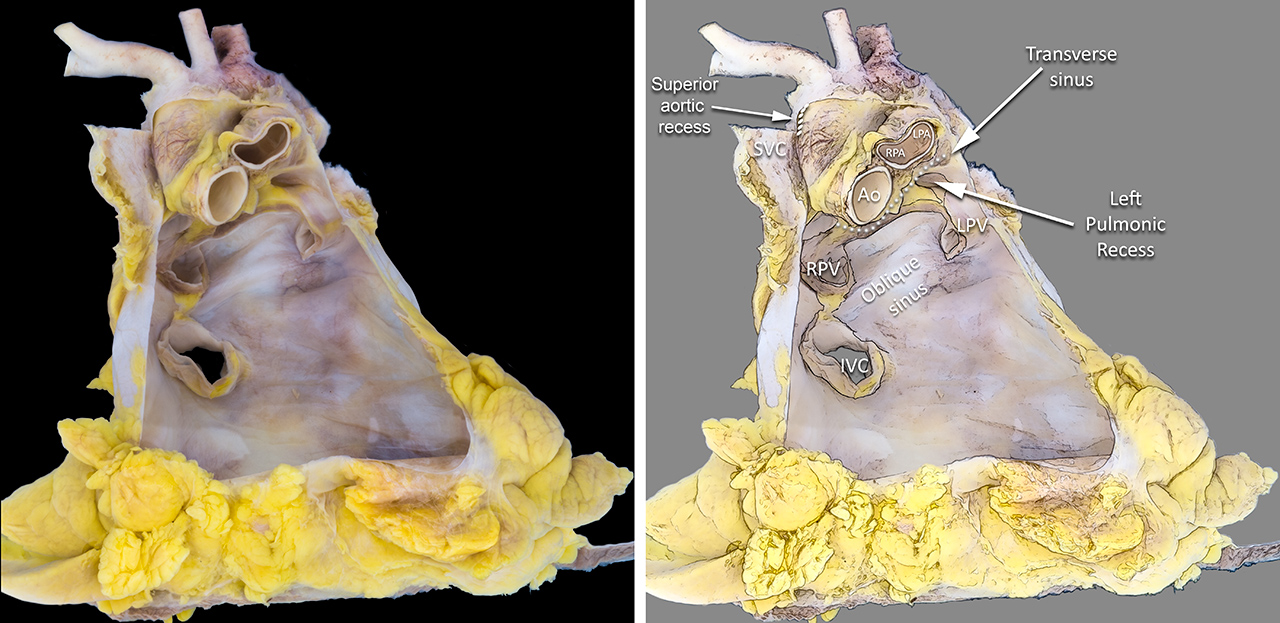
C. Microscopic Organization of the Pericardium
Three distinct layers can be defined in the parietal pericardium by microscopic exam: the serosa, the fibrosa, and an outer layer of epipericardial connective tissue. The serosa is the innermost surface of the pericardial sac and is formed by mesothelial cells [Figure 3]. The mesothelial cells are flat to cuboidal epithelial cells rich in microvilli which are important for the formation and reabsorption of pericardial fluid [Figure 5]. The fibrosa is composed of dense collagen bundles with interspersed scant elastic fibers [Figure 3]. The fibrous tissue bundles subjacent to the mesothelium tend to have a cephalocaudal orientation; whereas the more external bundles have a more weaved organization which allows for some distensibility of the pericardial fibrosa. The fibrosa contains scant connective tissue cells and small vessels. The outer pericardial layer shows somewhat more abundant elastic fibers, adipose tissue, neural elements, and blood vessels. Rare mast cells and mononuclear cells have been described in this layer.3
The visceral pericardium [Figure 3] is formed by a thin layer of fibrous tissue overlying the myocardium invested by mesothelial cells (the serosal component of the visceral pericardium) over the entire surface of the heart.
Figure 5
A sheet of mesothelial cells is shown at high magnification. These cells can vary from flat to cuboidal in shape. Microvilli (arrowheads) are present on the surface facing the pericardial cavity to increase the surface area of these cells. The microvilli impart a "fuzzy" look to the luminal border of the mesothelial cells.
D. Pericardial Responses to Injury
1. Distensibility
While the fibrous tissue bundles in the inner fibrosa with its cephalocaudal orientation do not distend very much; in comparison, the weaved organization of the fibrous tissue bundles of the external fibrosa allows for some distention of the pericardial sac before physiologic constriction is clinically evident. The specialized nature of the mesothelial cells with abundant microvilli and the fluid transport systems through these cells allow for high transport capacity through the serosal pericardium. The highly vascularized epicardium can provide large transfer of fluid to the mesothelial cells for these to produce transudates and exudates. This explains how simple transudates and/or highly fibrinous exudates can readily form in the pericardial cavity when there is injury.
2. Exudative and inflammatory response
The pericardium (parietal and visceral) has a limited response to injury, which is initially manifested as increased production of pericardial fluid.4 The effusion could be a transudate which is composed mostly of thin fluid or an exudate which contains large amounts of fibrin and, as a function of severity, variable numbers and types of inflammatory cells [Figure 6]. The fibrinous exudate forms adhesions and strands between the parietal and visceral pericardium. These fibrinous adhesions are the basis of the friction rub detected on physical examination [Figure 7]. With fibrinolysis, the fibrin deposits usually organize or heal into loose fibrous strands rather than dense fibrous tissue [Figure 8]. This type of repair does not result in constriction, since pockets lined with normal mesothelial cells are formed, which lubricate the remaining pericardial space. On the other hand, repeated bouts of fibrinous depositions or a more severe inflammatory injury can elicit a fibrogenic repair process.
Figure 6
Fibrinous exudate. Light micrograph of the epicardial surface of the myocardium showing mild inflammatory infiltrate in the myocardium and an exuberant eosinophilic fibrinous exudate on the surface of the visceral pericardium. The gross pathology of this fibrinous exudate is illustrated in Figure 7.
Figure 7
Gross specimen of a heart of a patient with uremic pericarditis completely covered with fibrinous strands which in addition show yellow/green discoloration as the patient had jaundice. Note that the fibrin strands surround the root of the great vessels as these segments are intrapericardial. Ao = aortic valve and aortic root. LV = left ventricle. PA = pulmonary artery and valve. RV = right ventricle. RVOT = right ventricular outflow tract. SVC = superior vena cava.
Figure 8
Coronal section of the heart showing organized fibrous (not fibrinous) strands (asterisk) formed between the visceral pericardium and the parietal pericardium. Note that the parietal pericardium is slightly thicker than the normal examples in Figure 3. LA = left atrium. LAA = left atrial appendage. LLL = left lower lobe of the lung. PA = pulmonary artery at bifurcation.
3. Reabsorption, organization and repair of the exudative inflammatory response
The healing process may show several alternative predominant patterns as shown in Figure 9. These responses can be of a single type or combined processes [Figure 10]. In some patients, the inflammatory infiltrates involve both the serosa of the pericardium and the serosa of the pleura [Figure 10].
Figure 9
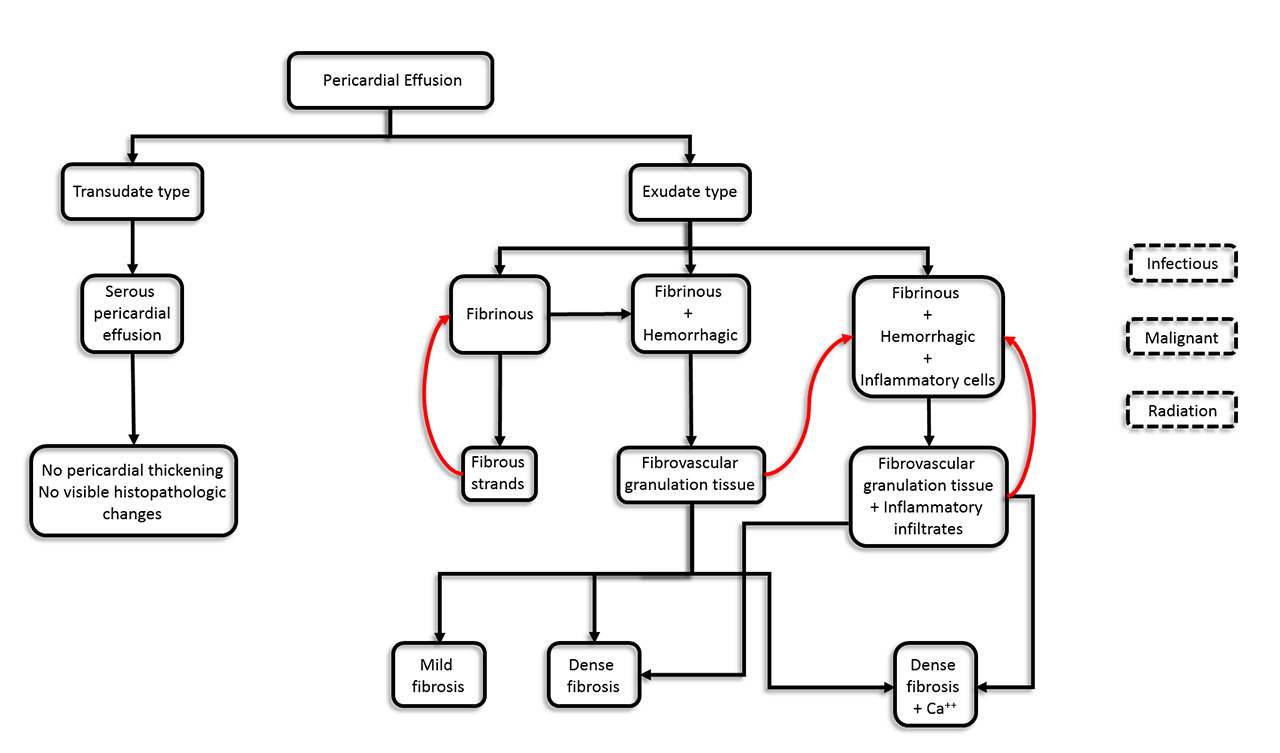
Figure 10
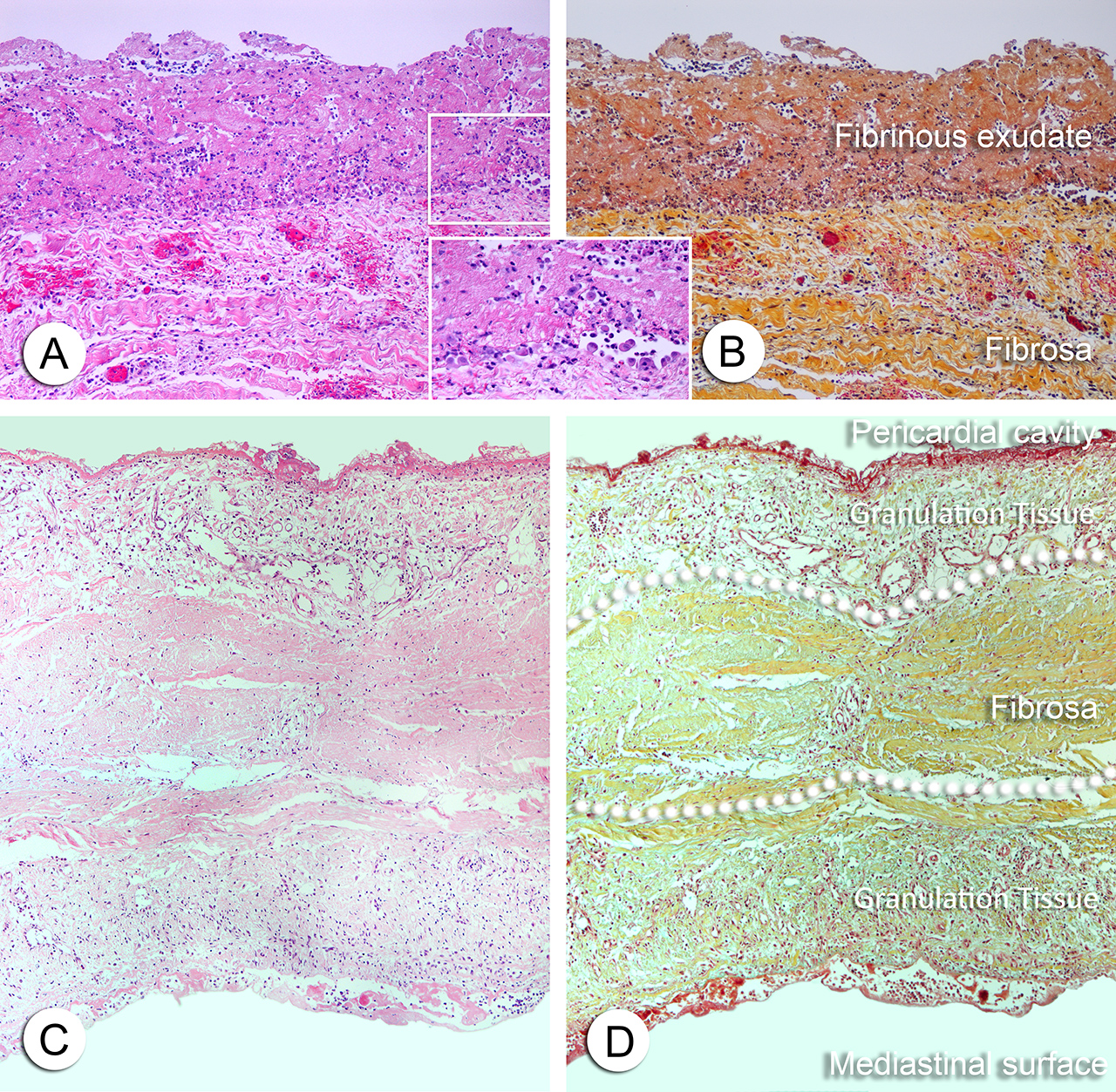
If no further injurious stimuli are present, the inflammatory cells within the fibrinous exudate promote neovascularization and fibroblast proliferation. Extracellular matrix is laid down and as it matures, the loose granulation tissue becomes organized with more mature fibrous tissue while the neovascularization and chronic inflammation become less conspicuous [Figure 11]. If the injurious stimulus that originated the effusion does not relapse, the healing process eventually leads to the maturation of the granulation tissue into a dense fibrous scar.
Figure 11
Organizing pericarditis with conspicuous neovascularization. Note that the fibrosa layer does not have very conspicuous vessels compared to the area of organizing fibrosis. (H&E stain and Movat pentachrome stain).
The fibrous proliferation of the pericardium may predominantly involve only one of the serosal components or may involve both the parietal and visceral pericardium. If repeated episodes of pericarditis occur (regardless of the etiology), the response of the pericardium is similar in producing new acute fibrinous and/or fibrino-hemorrhagic exudates which lead to new granulation tissue and more neovascularization [Figures 12 and 13]. Thus, chronic effusions may be associated with pericardial thickening. The neovascularization present in different stages of the organization of the pericardial effusion is the anatomic substrate of the late gadolinium enhancement on CMR imaging studies of pericarditis. Calcific deposition may be focal or extensive and likely represents an end-stage reaction to injury [Figure 14]. Because of the limited repertoire of tissue response of the pericardium to noxious stimuli, the histologic features of excised pericardium for constrictive pericarditis are generally nonspecific in terms of etiologic diagnosis and most often reflect a spectrum from organizing fibrinous pericarditis to organized fibrocalcific pericarditis.
Figure 12
Maturing organizing pericarditis. Loose edematous granulation tissue becomes organized into denser, thicker fibrous tissue as the amount of extracellular matrix and inflammation diminishes. Relative abundance of fibroblasts (fibroplasia) and newly-formed blood vessels are indicators of the activity of the process. Compare to Figure 13. (H&E stain and Movat pentachrome stain).
Figure 13
Organized pericarditis with recurrent insult. These micrographs show dense, mature bundles of fibrous tissue overlying the fibrosa layer of the pericardium. The neovascularization is less conspicuous than in the earlier stages of organization (Figures 11 and 12). In this example, there is increased cellularity in the upper strata of the pericardium towards the pericardial cavity. This innermost area towards the pericardial cavity shows abundant fibroblast proliferation or fibroplasia, shown as dark blue infiltrates in upper left area of the images. In addition, there is also fibrin and hemorrhage. This is a typical example of a recurrent process. (H&E stain and Movat pentachrome stain).
Figure 14
Dense fibrous pericarditis without calcification. The parietal pericardium is thickened due to the additional dense (yellow) fibrous tissue that shows no fibroblasts, inflammatory infiltrates or neovascularization. This represents a quiescent phase but may already be associated with pericardial constriction. (H&E stain and Movat pentachrome stain).
If the cause of the pericardial effusion is primary or metastatic malignant neoplasm, the malignant cells can be readily seen during microscopic examination [Figure 15].
Figure 15
Metastatic lung adenocarcinoma. An organizing fibrinous exudate containing metastatic tumor cells is present. Mild inflammatory infiltrate is noted in the fibrosa layer of the parietal pericardium. The inset shows a cluster of metastatic tumor cells with large pleomorphic nuclei in a channel lined by flat endothelial cells. (H&E stain and Movat pentachrome stain).
References
- Ferrans VJ IT, Roberts WC. Anatomy of the pericardium. In: Reddy PS LD, Shaver JA, eds. Pericardial Disease. New York: Raven Press; 1982:15-29.
- Levy-Ravetch M, Auh YH, Rubenstein WA, Whalen JP, Kazam E. CT of the pericardial recesses. AJR Am J Roentgenol 1985;144:707-14.
- Ishihara T, Ferrans VJ, Jones M, Boyce SW, Kawanami O, Roberts WC. Histologic and ultrastructural features of normal human parietal pericardium. Am J Cardiol 1980;46:744-53.
- Klein AL, Abbara S, Agler DA, et al. American Society of Echocardiography clinical recommendations for multimodality cardiovascular imaging of patients with pericardial disease: endorsed by the Society for Cardiovascular Magnetic Resonance and Society of Cardiovascular Computed Tomography. J Am Soc Echocardiogr 2013;26:965-1012.
Keywords: Pericardium, Adenocarcinoma, Adipose Tissue, Aorta, Thoracic, Aortic Valve, Cardiac Imaging Techniques, Carotid Artery Thrombosis, Cicatrix, Coloring Agents, Constriction, Endothelial Cells, Epithelial Cells, Extracellular Matrix, Fibrinolysis, Heart Ventricles, Inflammation, Mast Cells, Microvilli, Myocardium, Pericardial Effusion, Pericardiectomy, Pericarditis, Constrictive, Phrenic Nerve, Pulmonary Artery, Pulmonary Veins, Sagittaria, Vena Cava, Inferior, Vena Cava, Superior
< Back to Listings

